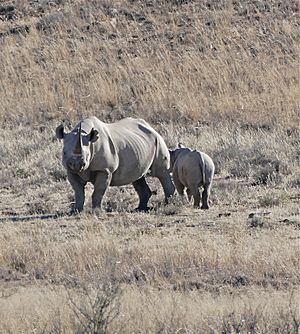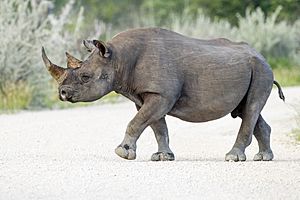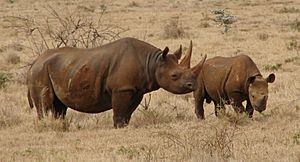Black rhinoceros facts for kids
The black rhinoceros, also called the black rhino or hook-lipped rhinoceros (Diceros bicornis), is a type of rhinoceros found in eastern and southern Africa. You can find them in countries like Kenya, Namibia, and South Africa. It is the only living species in its group, Diceros.
Quick facts for kids Black rhinoceros orhook-lipped rhinoceros |
|
|---|---|
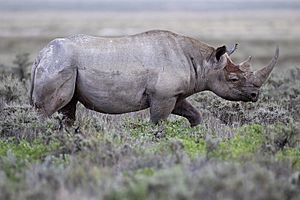 |
|
| A south-western black rhinoceros (D. b. occidentalis) in Etosha National Park, Namibia | |
| Conservation status | |
| Scientific classification | |
| Genus: |
Diceros
|
| Species: |
bicornis
|
| Subspecies | |
|
Diceros bicornis bicornis † |
|
 |
|
| Historical black rhinoceros range (ca. 1700 A.D.). Hatched: Possible historical range in West Africa. | |
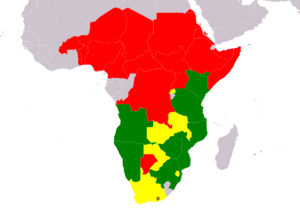 |
|
| Current black rhinoceros range Extant, resident Extinct Extant & Reintroduced (resident) Extant & Assisted Colonisation (resident) |
|
| Synonyms | |
|
|
Contents
- What Does a Black Rhino Look Like?
- Where Do Black Rhinos Live?
- How Do Black Rhinos Behave?
- What Do Black Rhinos Eat?
- How Do Black Rhinos Communicate?
- Black Rhino Reproduction and Life Cycle
- Protecting Black Rhinos
- What Threats Do Black Rhinos Face?
- Interesting Facts About the Black Rhinoceros
- Images for kids
- See also
What Does a Black Rhino Look Like?
An adult black rhino stands about 140 to 180 centimeters (55 to 71 inches) tall at the shoulder. They are usually 3 to 3.75 meters (10 to 12 feet) long. An adult rhino typically weighs from 800 to 1400 kilograms (1,760 to 3,080 pounds). Very large males can weigh up to 2896 kilograms (6,385 pounds). Female rhinos are smaller than males.
Black rhinos have two horns on their head made of keratin, which is the same material as your fingernails. The front horn is usually about 50 centimeters (20 inches) long, but can be as long as 140 centimeters (55 inches). Sometimes, they might even grow a third, smaller horn. Rhinos use their horns for defense, to scare off threats, and to dig up roots or break branches when they eat.
The black rhino is smaller than the white rhino. It has a pointed upper lip, which it uses to grab leaves and twigs. The white rhino, however, has square lips for eating grass. You can also tell black rhinos apart from white rhinos by their smaller skull and ears. Black rhinos also hold their heads higher because they eat leaves from bushes and trees, not grass from the ground.
Their thick skin protects them from thorns and sharp grasses. Sometimes, small bugs like mites and ticks live on their skin. Birds like oxpeckers and egrets might eat these bugs. People used to think this was a helpful relationship for both, but now some scientists believe oxpeckers might actually feed on the rhino's blood, acting more like parasites. Black rhinos have ears that can turn in many directions to hear sounds. They also have an excellent sense of smell, which helps them notice predators.
Where Do Black Rhinos Live?
Historically, black rhinos lived across most of southern and eastern Africa. They did not live in the Congo Basin or in very wet rainforest areas.
Today, black rhinos only live in protected nature reserves. They have disappeared from many countries where they once lived, especially in the west and north. The groups of rhinos that are left are very spread out. Some rhinos have been moved to safer places, sometimes even to different countries. For example, black rhinos were brought back to Malawi in 1993 after they had disappeared there. They were also reintroduced to Zambia in 2008 and to Botswana in 2003.
In 2017, 18 eastern black rhinos were moved from South Africa to Akagera National Park in Rwanda. This park had no rhinos left by 2007. A baby rhino was born there in September 2017, bringing the total to 19. The park has special teams to watch over the rhinos and protect them from poaching.
Later in 2017, the governments of Chad and South Africa agreed to move six black rhinos to Zakouma National Park in Chad. This will be the northernmost group of this species. Black rhinos were wiped out from Chad in the 1970s.
How Do Black Rhinos Behave?
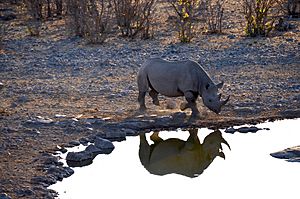
Black rhinos are usually solitary animals. The strongest bond is between a mother and her calf. They don't really defend their territories and often cross into other rhinos' areas.
Male rhinos tend to sleep more than females. Where they choose to sleep also affects how long they rest.
Black rhinos are known for being very aggressive. They often charge at anything they see as a threat, even tree trunks or termite mounds. Black rhinos also fight each other. Sadly, about 50% of male rhinos and 30% of female rhinos die from injuries they get during these fights.
Black rhinos often use the same paths that elephants use to get to water holes from their feeding areas. They also use smaller paths when they are eating leaves. They are very fast and can run up to 55 kilometers per hour (34 mph) on their toes.
What Do Black Rhinos Eat?
Black rhinos are herbivores that mostly eat leafy plants, branches, shoots, thorny bushes, and fruit. They prefer to live in areas with thick bushes and scrub, sometimes with some trees.
They are known to eat over 220 different types of plants. Black rhinos often choose food based on its quality rather than just how much there is. This means you might find more rhinos in places where the plants are more nutritious.
Black rhinos live in different habitats, including bushlands, forests near rivers, and marshes. They don't like grasslands as much. They look for food in the morning and evening. During the hottest part of the day, they are mostly inactive. They rest, sleep, or roll around in mud. Wallowing in mud helps them cool down and protects them from parasites. When black rhinos eat, they use their lips to strip leaves off branches.
How Do Black Rhinos Communicate?
Black rhinos use different ways to communicate. Because they are often alone, they use scent marking to let other rhinos know they are around. The urine and feces of a black rhino can tell other rhinos its age, sex, and who it is. Less often, they will rub their heads or horns against tree trunks to leave their scent.
Black rhinos have strong, tube-shaped ears that can turn in all directions. This excellent hearing allows them to detect sounds from far away.
Black Rhino Reproduction and Life Cycle
Adult black rhinos are solitary and only come together to mate. Mating can happen at any time of year, but births often occur at the end of the rainy season in dry areas.
Before mating, males might snort and spar (play-fight) with their horns. Another behavior is called "bluff and bluster," where the rhino snorts and swings its head aggressively before repeatedly running away. Mating pairs stay together for a few days, sometimes even weeks.
A female black rhino is pregnant for about 15 months. A single calf is born weighing about 35 to 50 kilograms (77 to 110 pounds). The calf can follow its mother after just three days. Young rhinos stop drinking their mother's milk around 2 years of age. The mother and calf stay together for 2 to 3 years until the next calf is born. Female calves might stay with their mothers longer, sometimes forming small groups. Young rhinos can sometimes be caught by hyenas and lions. Female rhinos can start having babies when they are 5 to 7 years old, and males can mate when they are 7 to 8 years old. In the wild, without poaching, black rhinos can live from 35 to 50 years.
Protecting Black Rhinos
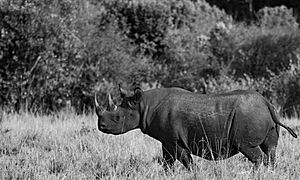
For most of the 20th century, the black rhino was the most common rhino species. Around 1900, there were probably hundreds of thousands in Africa. But in the second half of the 20th century, their numbers dropped sharply. From an estimated 70,000 in the late 1960s, they fell to only 10,000 to 15,000 by 1981. In the early 1990s, the number went below 2,500. By 2008, the total African population had recovered to 4,240. By 2009, the population of 5,500 was either stable or slowly growing.
In 1992, nine black rhinos were moved from Zimbabwe to Australia. After some males died naturally, four more males were brought from the United States. These rhinos have adapted well to their new home. Young rhinos and some smaller sub-adults can be hunted by lions. In 2011, a subspecies called the western black rhino was declared extinct. This happened despite efforts to move them to new habitats, as they did not adapt well.
The southern white rhinoceros is another rhino subspecies that has recovered well. Its numbers are now around 14,500, up from fewer than 50 in the early 1900s. There is also hope for black rhinos by using special methods to create embryos from dead rhinos in captivity.
In 2022, South Africa allowed hunting of 10 black rhinos, saying that their population is growing.
What Threats Do Black Rhinos Face?

Today, black rhinos face several threats. These include changes to their habitat, illegal poaching, and competition with other animals for food. Wars and conflicts have also had a negative impact on black rhino populations since the 1960s in countries like Chad, Rwanda, and Mozambique.
The biggest and most harmful threat is illegal poaching for the international rhino horn trade. People have been killing these animals for their horns for a long time. In the Middle East, rhino horn was used to make fancy handles for ceremonial daggers called jambiyas. The horn is also used in traditional Chinese medicine. Some Chinese beliefs also say that the horns allow a direct path to Heaven.
Interesting Facts About the Black Rhinoceros
- The black rhino was first named Rhinoceros bicornis by Carl Linnaeus in 1758.
- There are seven or eight subspecies of black rhinos. Three of these have become extinct in recent history, and one is very close to becoming extinct.
- Rhinoceroses first appeared about 50 million years ago.
- Even though they are called "black" rhinos, their colors can be brown or grey.
- The IUCN estimates that there are 3,142 mature black rhinos left in the wild.
- The longest black rhino horn ever found measured almost 1.5 meters (5 feet) long.
- People often think black rhinos have poor eyesight. However, studies show their eyesight is actually quite good, similar to a rabbit's.
- Adult rhinos usually have no natural predators because of their large size, thick skin, and dangerous horns.
- In rare cases, adult black rhinos have been attacked by crocodiles. Young calves, and very rarely small sub-adults, can also be hunted by lions.
- They can survive up to 5 days without water during dry periods.
Images for kids
See also
 In Spanish: Rinoceronte negro para niños
In Spanish: Rinoceronte negro para niños




